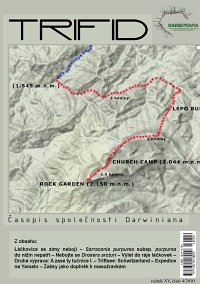Trifid 2010/4
Cephalotus isn´t afraid of the cold
Jakub Štěpán
A short article about Cephalotus follicularis and its tolerance to low temperatures. Most people don´t leave their plant outside when the weather gets colder, but they don´t have to. It can survive even a slight frost.
A few remarks from the yearly cultivation of pitcher plants in a garden moorland
Jan Řehoř
Why did the author decide to keep some of his plants outdoor all year? He describes how some plants of Sarracenia purpurea ssp. purpurea and Sarracenia flava behave, how they grow in different times of the year and why they often bloom twice a year and not once like plants kept indoors. He also adds a paragraph about other species and hybrids in his collection.
Don´t be afraid of Drosera arcturi
Adam Veleba
After some failures in keeping this highland sundew Adam was in position to get some seeds. This plant has a reputation of being difficult to grow and also a very slow growing sundew. But due to his patience Adam wrote this article with a lot of useful tips and advice, which can help you in successfully cultivate this pretty plant.
Trip to Nepenthes paradise – Borneo 2009, part IV
Václav Kubín
A short report from one day of expedition to Borneo. They found an amazing locality with a lot of Nepenthes species such as Nepenthes chaniana or Nepenthes reinwardtiana. The same day they moved off to a tour along a mountain edge and found another plants, for example Nepenthes lowii, Nepenthes muluensis, etc.
Charles Darwin: Insectivorous plants
Adam Veleba
Our librarian wants to present to you the oldest “book” about carnivorous plants, which was written by the well-renowned scientist – Charles Darwin. More than half of the book is solely about Drosera rotundifolia and rest of the book is for example about Utricularia neglecta (nowadays more commonly known Utricularia australis) or Polypompholyx. There are also some descriptions of experiments in the book and not only with Drosera rotundifolia but with other.
Second expedition – Butterworts again, part I
Jaroslav Neubauer, Mirek Macák, Pepa Malínský
A return to locations in Switzerland and France. They headed directed for a moorland with a lot of Sarracenia purpurea plants. Compared to their first visit there were a lot more plants of different size and age. They also found Pinguicula vulgaris. After a thorough inspection of this location the authors went to France, where they wanted to see Pinguicula grandiflora, Pinguicula alpina and Pinguicula grandiflora ssp. pallida. Despite the problems of recognizing the old places that they knew, the first part of their trip was successful and they found all that they wanted to, including Pinguicula grandiflora ssp. rosea.
Triftsee – Switzerland
Martin Dlouhý
Due to an internship Martin spent two months in Switzerland. Switzerland meaning the Alps, so some trip to Pinguicula alpine was clear. But this article is about his first trip, that wasn´t focused on carnivorous plants. The author writes about a trek to the Triftsee lake and the glacier above it. And to his surprise he found some plants of Pinguicula alpina.
CP expedition to Yamato – part II and III
Sebastian Vieira
The second part of the report from the expedition to Yamato is about a small specific location, where you can only find three species of Utricularia. The third part is much more interesting. Not only bladderworts can be found there. The first plant the author saw was Drosera communis and a part of this text mentions the differences between plants on flooded and non-flooded parts of this location.
Frogs as a supplement to carnivorous plants
Jakub Štěpán
A lot of growers also have a vitrine with carnivorous plants. And Jakub is no different except for the fact that he also has small tropical frogs with his plants. In the first part of the article, there is a general description of a group of tree frogs. He also writes about what is used to feed and a short mention of how to breed them. The second part consists of answers to some basic questions about such as where we can get them, what equipment they need and how they can live together with carnivorous plants.
